The document presents a modified artificial bee colony (moabc) optimization algorithm aimed at enhancing content-based image retrieval (CBIR) systems. It emphasizes the algorithm's effectiveness in minimizing feature vector dimensions while improving the retrieval performance compared to existing methods like particle swarm optimization and genetic algorithms. The paper outlines the role of color, texture, and shape in feature extraction and suggests an optimization framework applicable to various image databases.
![International Journal of Engineering Research and Development
e-ISSN: 2278-067X, p-ISSN: 2278-800X, www.ijerd.com
Volume 10, Issue 4 (April 2014), PP.19-29
19
Modified Optimization by Artificial Bee Colony (MOABC) for
improvement in content-based image retrieval performance
Anil Kumar Mishra1
, Madhabananda Das2
, Tarini Charan Panda3
1
Orissa Engineering College, Bhubaneswar
2
KIIT University, Bhubaneswar
3
Orissa Engineering College Bhubaneswar
Abstract:- Artificial Bee Colony(ABC) algorithm based optimization techniques are quite popular and focus for
research in fields of Swarm Intelligence. This paper presents an optimization algorithm based on artificial bee
colony (ABC) to deal with optimization problems in Content Based Image Retrieval (CBIR) System. We have
introduced a modified ABC algorithm which is based on the intelligent scavenging behaviour for content base
images. It uses less control parameters, and it can be efficiently used for solving for multi object optimization
problems. In the current work, MOABC for discrete variables has been developed and implemented successfully
for the multi variable design optimization of composites. The proposed algorithm is applied to Image retrieval
section of CBIR system for minimizing the feature vectors and to find the image similar to the queried image.
Finally the performance is evaluated in comparison with other nature inspired techniques which includes
Particle Swarm Optimization (PSO) and Genetic Algorithm (GA). The performance of MOABC is better as par
with that of ABC, PSO and GA for all the loading configurations.
Keywords:- Multi variable optimization, Structural optimization, Artificial Bee Colony (ABC), Feature
Extraction.
I. INTRODUCTION
Content-based image retrieval is a method which expenditures visual contents to search images from
bulky scale image databases according to users interests it is also known as query by image content. Since 1900s
Content-based image retrieval has been an active and fast advancing research area. [1][5] CBIR comes to picture
when many applications with large image database, traditional methods of image indexing have recognized to
be unsatisfactory. Finger print scanning system, Automatic face recognition system, Medical image database,
Trademark image registration are the application of Content-based image retrieval (CBIR). [6][7] The process of
CBIR consists of three stages namely Image acquisition, Feature Extraction and Similarity Matching. In CBIR
first of all query image undergoes the three stages as mentioned above. The query image is then compared with
the images in the image database. All the images in the database undergo feature extraction so that the resultant
feature vector can be compared with the feature vector of the query image. The closest image in comparison
with the query image from the feature database is returned [8][10].
Multivariable optimization is defined as a problem of finding a vector of decision variables which
fulfils constraints and enhances a vector function whose element characterizes the objective functions and these
functions form a mathematical description of performance criteria which are usually in clash with each other [9]
[11]. The biggest problem for CBIR system is to incorporate useful techniques so as to procedure images of
expanded features and types. There are numerous methods for processing of low level cues are distinguished by
the characteristics of domain-images.[14] The performance of these methods is tested by various issues like
image resolution, intra-image illumination variations, non-homogeneity of intra-region and inter-region textures,
multiple and occluded objects etc. [4] [15] The other key trouble, is a gap between inferred understanding
semantics by pixel domain processing using low level cues and human perceptions of visual cues of given
image[16]. The content based image retrieval system comprises of multiple inter-dependent tasks performed by
various phases and Inter-tuning of all these phases of the content based retrieval system is unavoidable for over
all good results. The diversity in the images and semantic-gap generally enforce parameter tuning & threshold-
value specification suiting to the requirements [17].
In 2005 Karaboga proposed the artificial bee colony algorithm (ABC) is an optimization algorithm
based on the intelligent foraging behaviour of honey bee swarm [18]. In ABC model, the colony consists of
three groups of bees namely employed bees, onlookers and scouts. In this model it is assumed that there is only
one artificial employed bee for each food source [19]. Employed bees go to their food source and come back to
hive and dance on this area. The employed bee whose food source has been abandoned becomes a scout and
starts to search for finding a new food source [2]. Onlookers watch the dances of employed bees and choose](https://image.slidesharecdn.com/c1041929-140507022829-phpapp01/75/International-Journal-of-Engineering-Research-and-Development-1-2048.jpg)
![Modified Optimization by Artificial Bee Colony (MOABC) for improvement in content-based image retrieval...
20
food sources depending on dances. Optimal multi-level thresholding, MR brain image classification, cluster
analysis, face pose estimation and 2D protein folding etc. these are the applications of ABC [20].
II. RELATED RESEARCHES: A REVIEW
Despite a plenty of works available in the literature, a handful of significant research works are reviewed here.
Chih-Chin Laiet.al [21] have discussed about a user-oriented mechanism for CBIR method and in this
paper we used interactive genetic algorithm. IGA is a branch of evolutionary computation. The main difference
between IGA and GA is the construction of the fitness function, i.e., the fitness is determined by the user‟s
evaluation and not by the predefined mathematical formula. A user can interactively determine which members
of the population will reproduce, and IGA automatically generates the next generation of content based on the
user‟s input. Through repeated rounds of content generation and fitness assignment, IGA enables unique content
to evolve that suits the user‟s preferences. Based on this reason, IGA can be used to solve problems that are
difficult or impossible to formulate a computational fitness function, for example, evolving images, music,
various artistic designs, and forms to fit a user‟s aesthetic preferences. In this paper IGA is employed to help the
users identify the images that are most satisfied to the users‟ need.
Lei Wu et.al [22] have proposed a method on Tag Completion for Image Retrieval, the proposed
method falls into the category of semi-supervised learning in that both tagged images and untagged images were
exploited to find the optimal tag matrix. In this proposed method also evaluated tag completion by performing
two sets of experiments, i.e., automatic image annotation and tag based image retrieval. In this proposed method,
they focus on a study the problem of tag completion where the goal was to automatically fill in the missing tags
as well as correct noisy tags for given images.
Yingying Wang et.al [23] have proposed a model image classification as a Multiple Instance Learning
(MIL) problem, by regarding each image as a bag composed of different regions/patches. In this proposed
method rate distortion multiple instance learning (RDMIL) to take advantage of witnesses to improve the
performance of MIL for image classification task. The objective function of RDMIL was decomposed into two
convex sub-problems, which can be solved by alternating technique. Especially they design a sequential method
to effectively optimize the RD sub problem. Experimental results on two real-world datasets demonstrate the
proposed RDMIL algorithm was effective and promising. That approached well illustrates the generative
process of witnesses and measures the diverse importance of instances in a probabilistic approach.
H. B Kekre et.al [24] have proposed a method on the selection of suitable similarity measure for
content based image retrieval. It contains the analysis done after the application of similarity measure named
Minkowski Distance from order first to fifth. It was also explains the effective use of similarity measure named
correlation distance in the form of angle „cosθ‟ between two vectors. In this proposed method the „Bins
Approach‟ explained the terms of computational complexity for feature extraction. It was based on histogram
partitioning of three colour planes. As histogram was partitioned into 3 parts, they could form 27 bins out of it.
These bins were directed to extract the features of images in the form of four statistical moments namely Mean,
Standard Deviation, Skewness and Kurtosis.
Ramadass Sudhir et.al [25] proposed an algorithm image retrieval technique, which used YUV colour
space and wavelet transform approach for feature extraction. Firstly, the colour space was quantified in non-
equal intervals, then constructed one dimension feature vector and represented the colour feature. Similarly, the
texture feature extraction was obtained by using wavelet. Finally, colour feature and texture feature were
combined based on wavelet transform. Based on the colour feature, the rich colour images, such as the type of
landscape images or planes, the colour characteristics of the use of regular search colours can be similar to the
image. The use of colour and texture features of wavelet transform was more suitable for segmentation of
objects and classification of related image from thousands of images. In which the retrieved images were much
similar when the YUV is used and the retrieval time is also less when comparing with the previous RGB and
HSV methods.
B.Ramamurthy et.al [26] have proposed to retrieve the medical images from huge volume of medical
databases. This requires the pre-processing, feature extraction, classification, retrieval and indexing steps in
order to develop an efficient medical image retrieval system. In this proposed work, for pre-processing step, the
image segmentation method have been carried out, for feature extraction, basic shape feature has been extracted
using canny edge detection algorithm, and for classification, K-means classification algorithm has been used.
They have realize that Canny Edge Detection and K-means clustering algorithms are quite useful for retrieval of
relevant images from image database. The results of this proposed indicate that the proposed approach offers
significant performance improvements in retrieval of medical images. Further, by fine tuning of shape feature
extraction and using other shape feature extraction methods, performance of the retrieval process can be
improved more.](https://image.slidesharecdn.com/c1041929-140507022829-phpapp01/75/International-Journal-of-Engineering-Research-and-Development-2-2048.jpg)
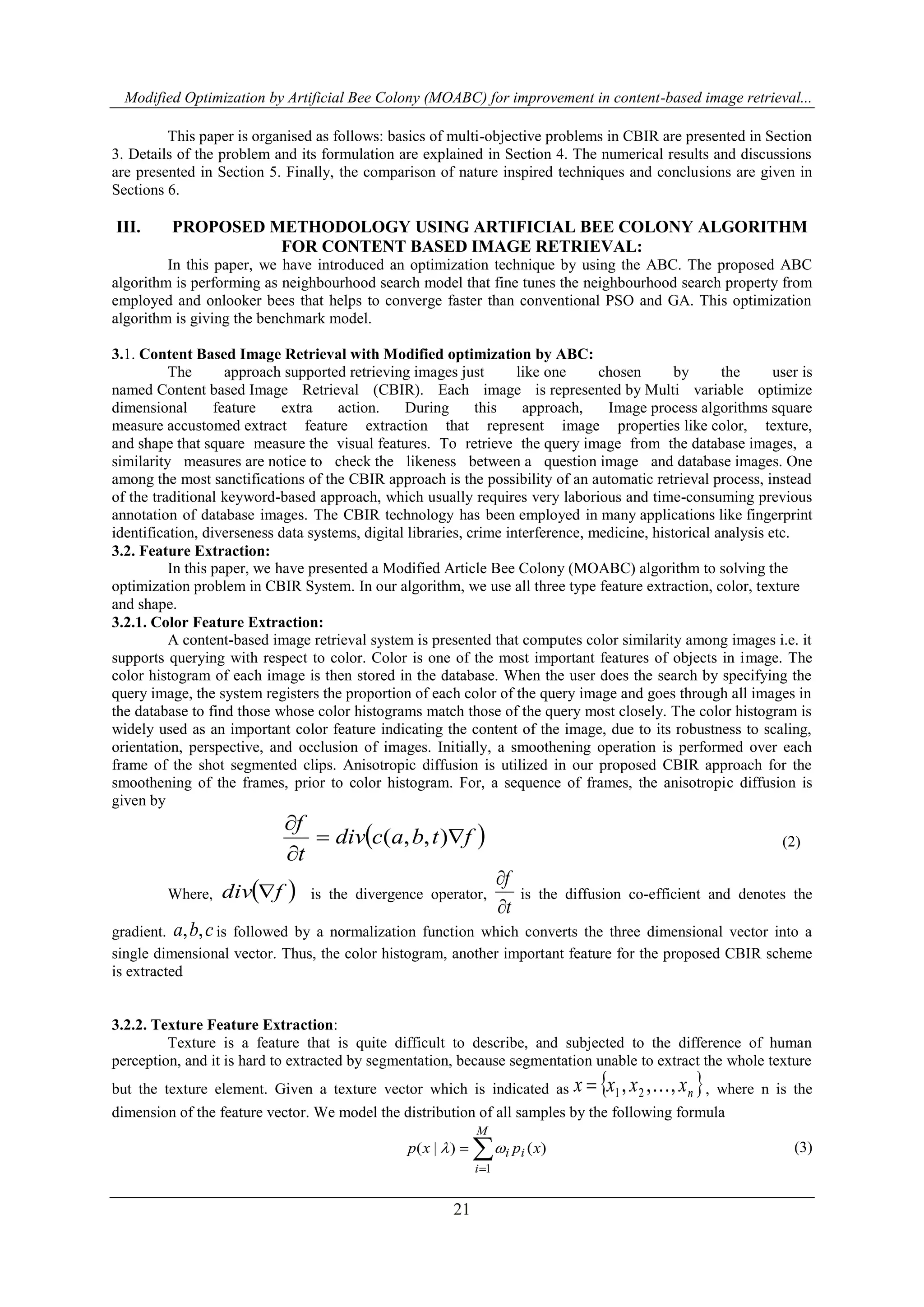
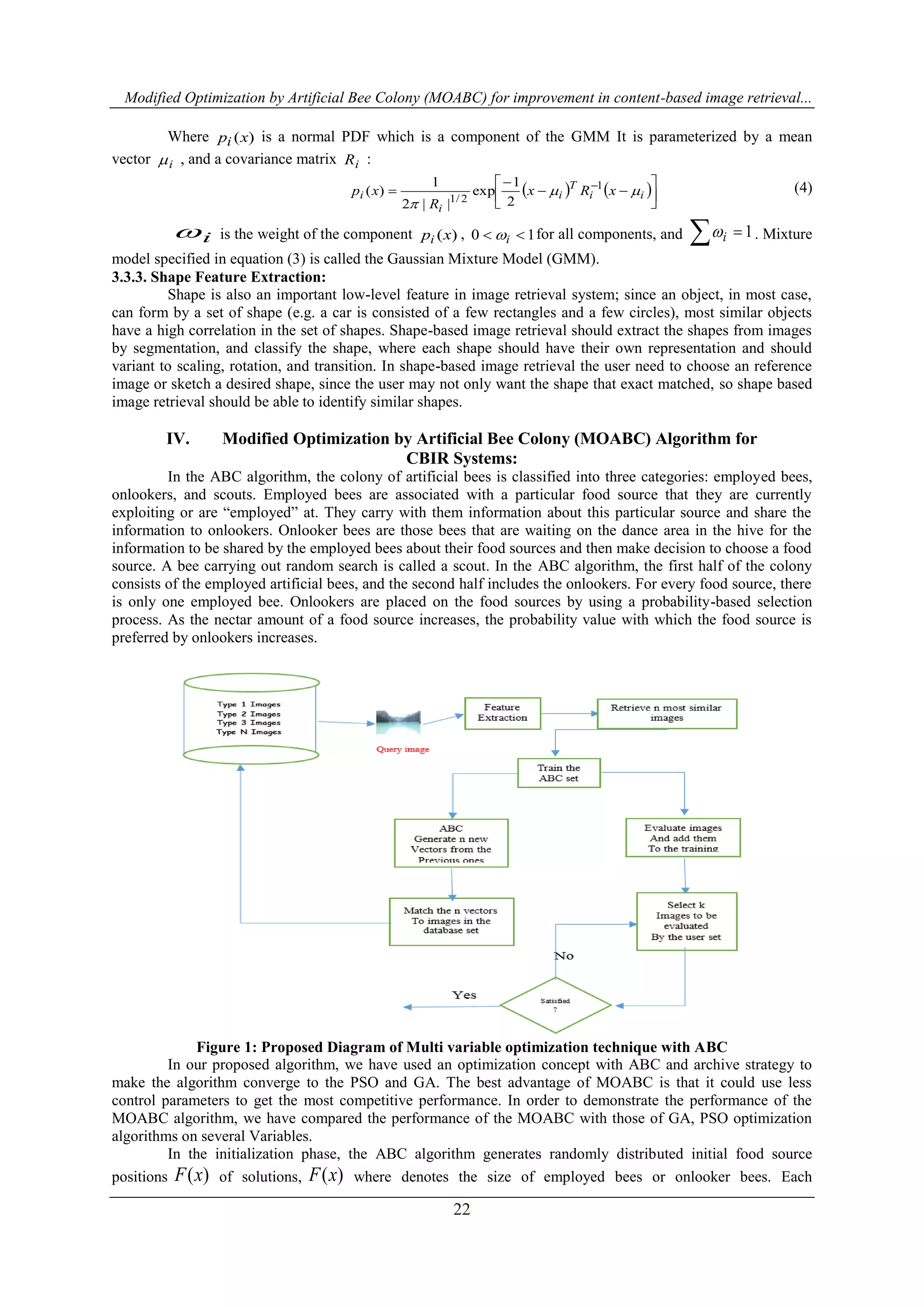
![Modified Optimization by Artificial Bee Colony (MOABC) for improvement in content-based image retrieval...
23
solution ))(........,),(),(()( 21 xfxfxfxF n is a n -dimensional vector. Here, n is the number of
optimization parameters. And then evaluate each nectar amount. In the ABC algorithm, nectar amount is the
value of benchmark function.
Employed Bees’ Phase:
In the employed bees‟ phase, each employed bee finds a new food source iV in the neighbourhood of
its current source ix . The new food source is calculated using the following expression:
)( kjijijijij xxxV (8)
where )....3,2,1( mk and )....3,2,1( nj are randomly chosen indexes and ijik . k is a
random number between [-1, 1]. It controls the production of a neighbour food source position around ijx . Then
employed bee compares the new one against the current solution and memorizes the better one by means of a
greedy selection mechanism.
Onlooker Bees’ Phase:
In the onlooker bees‟ phase, each onlooker chooses a food source with a probability, which is related to
the nectar amount (fitness) of a food source shared by employed bees. Probability is calculated using the
following expression:
(9)
Here if is fitness function and ifit is the fitness after a transformation.
Scout Bee Phase:
In the scout bee phase, if a food source cannot be improved through a predetermined cycles, called
“limit”, it is removed from the population, and the employed bee of that food source becomes scout. The scout
bee finds a new random food source position using
M
i i
i
i
f it
f it
p
1 (10)
Here M is the number of food source and if is fitness function of the
th
i food source. Finally,
chose a candidate solution based on the section probability by “roulette wheel section”, method. The best ones
then get quite the same selection probability as the others and the algorithm stops progressing.
Pseudo code of MOABC algorithm:
1. Step 1: Generates randomly distributed initial food source in cycle = 1
2. Step 2: Initialize the food source positions (solutions)
3. Step 3: Evaluate the nectar amount (fitness function ) of food sources
4. repeat
5. Step 4: Employed Bees‟ Phase
6. For each employed bee
7. Produce new food source positions
8. Calculate the value
9. If new position better than previous position
10. Then memorizes the new position and forgets the old one.
11. End For.
12. Step 5: Calculate the values for the solution.
13. Step 6: Go to 2nd
Phase (Onlooker Bees)
14. For each onlooker bee
15. Chooses a food source depending on
16. Produce new food source positions
17. Calculate the value
18. If new position better than previous position](https://image.slidesharecdn.com/c1041929-140507022829-phpapp01/75/International-Journal-of-Engineering-Research-and-Development-5-2048.jpg)
![Modified Optimization by Artificial Bee Colony (MOABC) for improvement in content-based image retrieval...
24
19. Then memorizes the new position and forgets the old one.
20. End For
21. Step 7: Go to 2nd
Phase (Scout Bee Phase)
22. If there is an employed bee becomes scout
23. Then replace it with a new random source positions
24. Step 8: Memorize the best solution achieved so far
25. Step 9: Cycle = cycle + 1.
26. Step 10: until cycle = Maximum Cycle Number
27. Evaluate each particle in the size of home
28. Step 11: Perform the optimal solution check for all the particles:
29. if the Calculated value is best xi is dominated by the new
solution, then xi is replaced by the new solution.
Table 1: Pseudo code of MOABC algorithm
After Step 10.The proposed algorithm performance of the approach is based on the precision; recall
and F-measure cross over points. After evaluating Euclidean distance of the query image, the precision and
recall values are generated using the following equations (8), (9) and (10) in[27].
retrivdimagesofnoTotal
retreivedimagesrelevantofNo
precision
.
.
(8)
databaseinimagesrelevantofnoTotal
retreivedimagesrelevantofNo
recall
.
.
(9)
recallprecision
recallprecision
F
*
2 (10)
V. EXPERIMENTAL RESULT
We will introduce performance measures. For every algorithm, we will give the parameter settings. The
propose technique is tested on the image database of 500 variable images includes five categories as some
different types of butterflies and flowers with 200 images for each datasets. The precision, recall and F-measure
are calculated for the sample query images for each category using Eq. (8), (9) and (10). These measures are the
important parameters to judge the performance of the algorithms. Precision is the fraction of the relevant images
which has been retrieved, checks the completeness of the algorithm. Recall is the fraction of the relevant images
which has been retrieved, checks the accuracy of the algorithm. After that we compare with the proposed result
with single object optimization technique of ABC, PSO and GA.
Table 2: Total number of Retrieved dataset 1 images for MOABC, ABC, PSO and GA
MOABC ABC PSO GA
Precision 0.74 0.68 0.62 0.53
Recall 0.70 0.62 0.58 0.47
F-score 0.66 0.59 0.48 0.45
Table 3: Total number of Retrieved dataset 2 images for MOABC, ABC, PSO and GA
MOABC ABC PSO GA
Precision 0.80 0.78 0.29 0.24
Recall 0.64 0.67 0.48 0.15
F-score 0.57 0.51 0.38 0.17
Table 4: Total number of Retrieved dataset 3 images for MOABC, ABC, PSO and GA
MOABC ABC PSO GA
Precision 0.69 0.70 0.56 0.45
Recall 0.70 0.38 0.51 0.57
F-score 0.63 0.21 0.44 0.50](https://image.slidesharecdn.com/c1041929-140507022829-phpapp01/75/International-Journal-of-Engineering-Research-and-Development-6-2048.jpg)
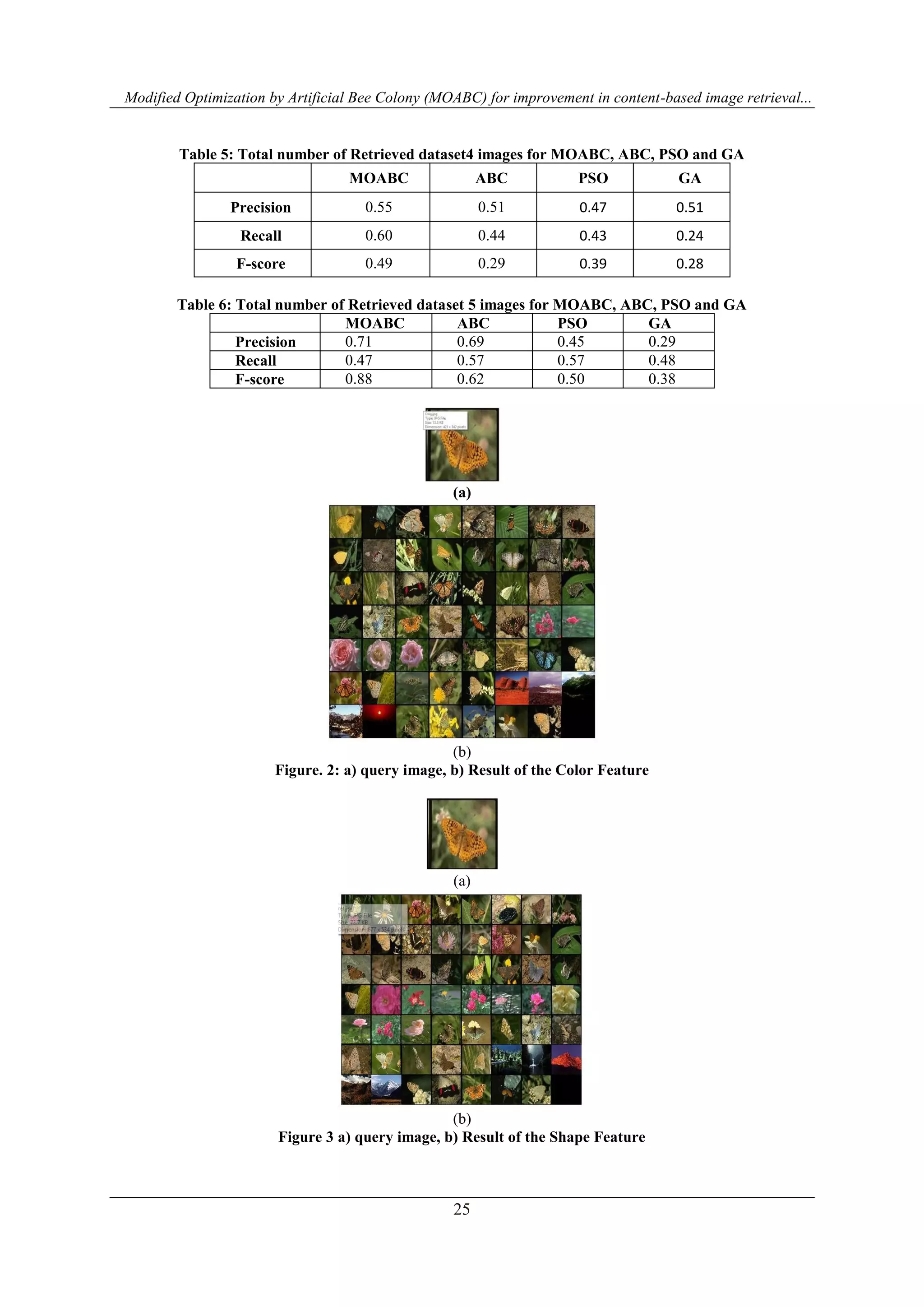
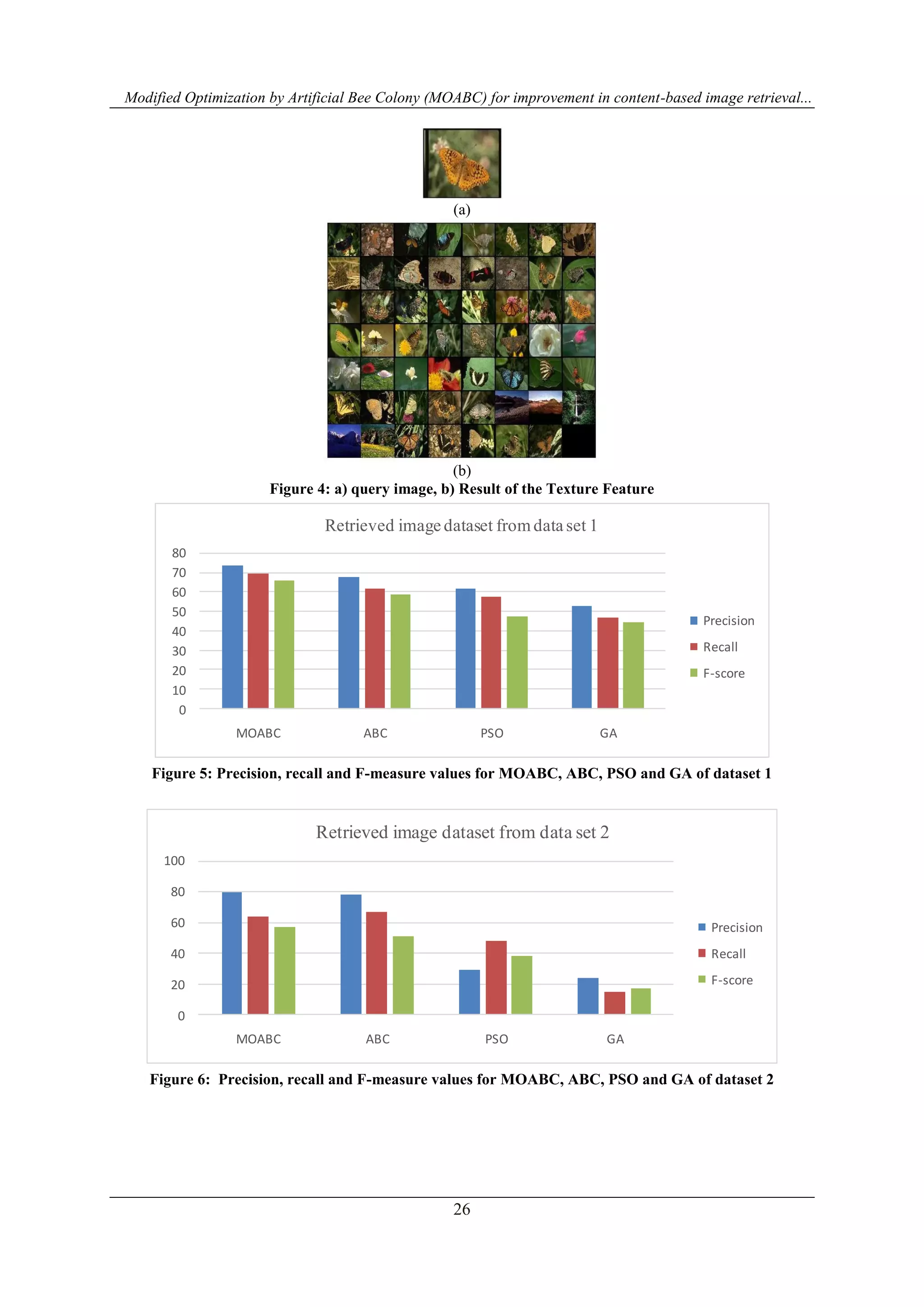
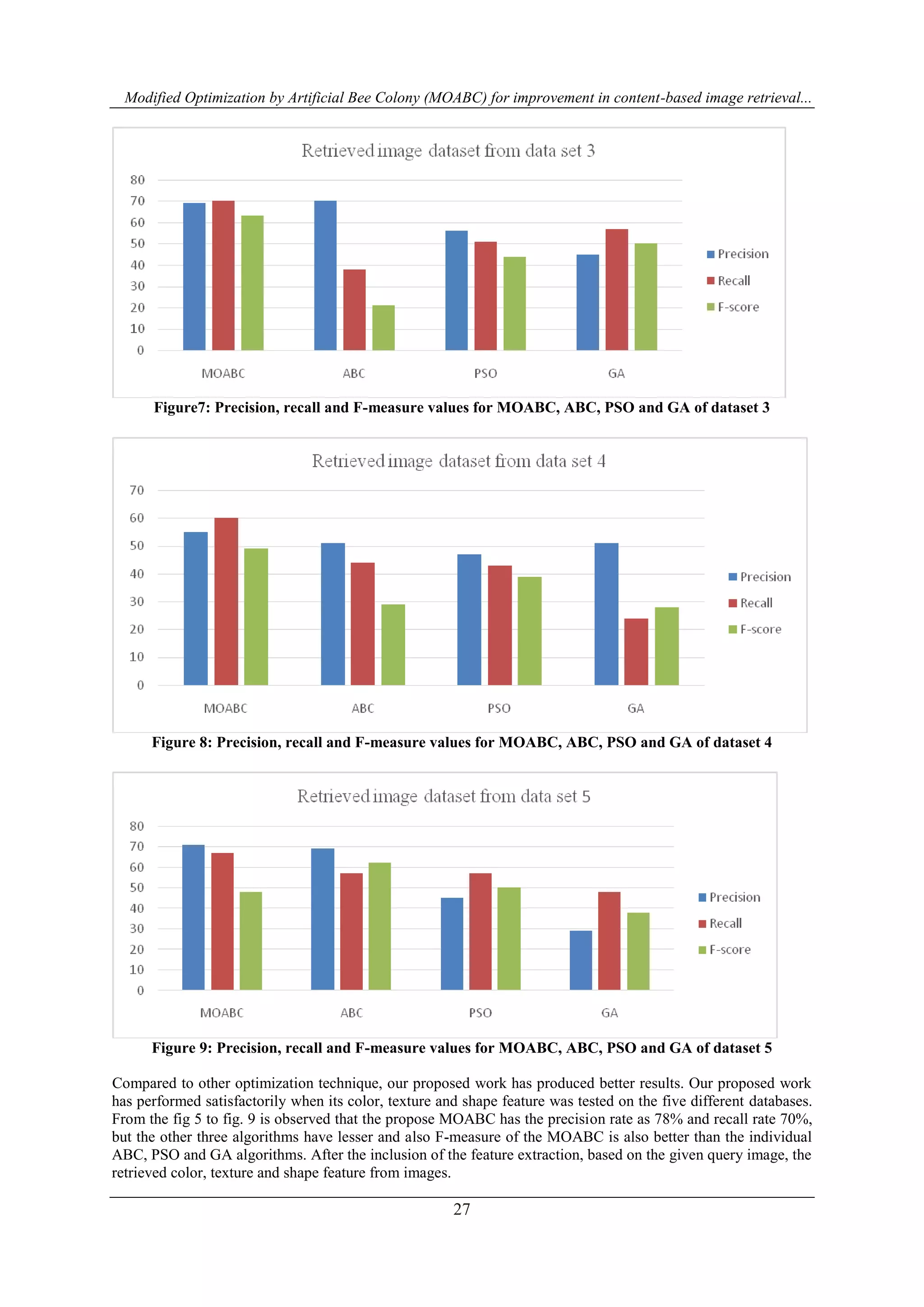
![Modified Optimization by Artificial Bee Colony (MOABC) for improvement in content-based image retrieval...
28
In the all five different dataset retrieval were performed by querying five different images and for every
dataset we get precision, recall and F-score values is determined. The precision and recall value comparison
between the proposed extensive algorithms features extraction based on multi-variable optimization systems
shows that the performance of the proposed system is best over that of the existing systems. Thus the
comparisons are made using multiple features such as color, texture, shape that the proposed MOABC algorithm
performs better than the individual ABC, PSO and GA.
VI. CONCLUSION
In this paper the new method (MOABC) is introducing multi variable updation in ABC algorithm, PSO
and GA instead of single optimization Search. Here it is implemented in MATLAB and is tested by using
different evaluation functions. The parameter position is optimized for multiple object and the values of the
propposed method is compared with single object ABC, PSO and GA algorithm. In the proposed method the
fitness values are seems to be better for the Precision Recall and F-score value found to be better in all single
evaluationary algorithems. From the above results it is clear that the MOABC is the better optimization
technique while comparing to ABC, PSO and GA.
REFERENCES
[1]. Binitha S, S Siva Sathya, “A Survey of Bio inspired Optimization Algorithms”, International Journal of
Soft Computing and Engineering, Vol. 2, No. 2, pp. 137-151, 2012.
[2]. Nabeel Mohammed and David McG. Squire,"Effectiveness of ICF features for collection-specific
CBIR", 9th International Workshop on information Systems and Applications, Vol. 7836, pp. 83-95,
2013.
[3]. Jun Wang, Sanjiv Kumar, and Shih-Fu Chang,"Semi-Supervised Hashing for Large Scale Search",
IEEE Transactions on Pattern Analysis and Machine Intelligence, Vol. 34, No. 12, pp. 2393- 2406,
2012.
[4]. Swati V. Sakhare and Vrushali G. Nasre,"Design of Feature Extraction in Content Based Image
Retrieval(CBIR) using Color and Texture", International Journal of Computer Science & Informatics,
Vol. 1, pp. 57-62, 2011.
[5]. Vibha Bhandari and Sandeep B.Patil,"Comparison of CBIR Techniques using DCT and FFT for
Feature Vector Generation", International Journal of Emerging Trends & Technology in Computer
Science, Vol. 1, No. 4, pp. 1-10, 2012.
[6]. Marıa Jimena Costa, Alexey Tsymbal, Matthias Hammon, Alexander Cavallaro, Michael
Suhling,Sascha Seifert and Dorin Comaniciu,"A Discriminative Distance Learning–Based CBIR
Framework for Characterization of Indeterminate Liver Lesions", Vol. 7075, pp. 92-104, 2012.
[7]. Wasim Khan, Shiv Kumar, Neetesh Gupta and Nilofar Khan,"Signature Based Approach For Image
Retrieval Using Color Histogram And Wavelet Transform", International Journal of Soft Computing
and Engineering, Vol. 1, No. 1, pp. 43-50 March 2011.
[8]. H.B.Kekre, Dhirendra Mishra, Stuti Narula and Vidhi Shah,"Color Feature Extraction for CBIR",
International Journal of Engineering Science and Technology, Vol.1, pp. 1- 10, 2011.
[9]. Robert Huitl, Georg Schroth, Sebastian Hilsenbeck, Florian Schweiger and Eckehard
Steinbach,"VirtualReference View Generation for CBIR-based Visual Pose Estimation", pp. 993-996,
2012.
[10]. Sri Rama Krishna, A. Guruva Reddy, M.N.Giri Prasad, K.Chandrabushan Rao, M. Madhavi, "Genetic
Algorithm Processor for Image Noise Filtering Using Evolvable Hardware," International Journal of
Image Processing, Vol. 4, No. 3, Pp.240-251, 2010.
[11]. Jakia Afruz, Va Juanna Wilson,"Frequency Domain Pseudo-color to Enhance Ultrasound Images," In.
Proc. of Computer and Information Science, Vol. 3, No. 4, Pp. 24-34, Nov. 2010.
[12]. Grant J. Scott, Matthew N. Klaric, Curt H. Davis and Chi-Ren Shyu,"Entropy-Balanced Bitmap Tree
for Shape-Based Object Retrieval From Large-Scale Satellite Imagery Databases", IEEE Transactions
On Geoscience and Remote Sensing, VOL. 49, pp. 5, 2011.
[13]. H. B. Kekre and Kavita Sonawane,"Effect of Similarity Measures for CBIR Using Bins Approach",
International Journal of Image Processing, Vol. 6, pp. 182-190, 2012.
[14]. Edward Kim, Sameer Antani, Xiaolei Huang, L.Rodney Long and Dina Demner-Fushman,"Using
Relevant Regions in Image Search and Query Refinement for Medical CBIR", Society for Imaging
Informatics in Medicine, Vol. 21, pp. 280-289. 2207.
[15]. Gerald Schaefer, "Content-Based Image Retrieval – Some Basics", Advances in Intelligent and Soft
Computing, Vol. 103, pp 21-29, 2011.](https://image.slidesharecdn.com/c1041929-140507022829-phpapp01/75/International-Journal-of-Engineering-Research-and-Development-10-2048.jpg)
![Modified Optimization by Artificial Bee Colony (MOABC) for improvement in content-based image retrieval...
29
[16]. Ch. Kavitha, B. Prabhakara Rao and A. Govardhan,"Image Retrieval Based On Color and Texture
Features of the Image Sub-blocks", International Journal of Computer Applications, Vol. 15, No.7, pp.
975 – 8887, 2011.
[17]. Sushil Kumar Singh, Aruna Kathane,"Various Methods for Edge Detection in Digital Image
Processing," International journal of computer science and technology, Vol. 2, No. 2, Pp. 188-190,
June 2011.
[18]. Gulfishan Firdose Ahmed, Raju Barskar,"A Study on Different Image Retrieval Techniques in Image
Processing, "International Journal of Soft Computing and Engineering, Vol. 1, No. 4, Pp.247-251, Sep.
2011.
[19]. V. Selvi, R. Umarani, “Comparative Study of Swarm Intelligence Techniques”, International Journal of
Research in Engineering Design, Vol 01, No. 01, pp. 37-41, April - July 2012.
[20]. Milos Subotic, Milan Tuba and NadezdaStanarevic, “Different approaches in parallelization of the
artificial bee colony algorithm”, International Journal of Mathematical Models And Methods in
Applied Sciences, Vol. 5, No. 4, pp. 755-762, 2011
[21]. Chih-Chin Lai, and Ying-Chuan Chen,"A User-Oriented Image Retrieval System Based on Interactive
Genetic Algorithm", IEEE Transactions on Instrumentation and Measurement, Vol. 60, No. 10, pp. 1-
10, 2011.
[22]. Lei Wu, Rong Jin and Anil K. Jain,"Tag Completion for Image Retrieval", IEEE Transactions On
Pattern Analysis and Machine Intelligence, Vol. 35, No. 3, pp. 716-727, 2013.
[23]. Yingying Wang, Chun Zhang and Zhihua Wang,"Rate Distortion Multiple Instance Learning For
Image Classification", IEEE International Confrence On Image Prossecing, PP. 3235-3240, 2013.
[24]. H. B. Kekre and Kavita Sonawane,"Bin Pixel Count, Mean and Total of Intensities Extracted From
Partitioned Equalized Histogram for CBIR", International Journal of Engineering Science and
Technology, Vol. 4, pp. 1233- 1240, 2012.
[25]. Ramadass Sudhir and S. Santhosh Baboo,"An Efficient CBIR Technique with YUV Color Space and
Texture Features", Computer Engineering and Intelligent Systems, Vol. 2, No.6, pp. 78-85, 2011.
[26]. B.Ramamurthy and K.R.Chandran,"CBIR: Shape-Based Image Retrieval Using Canny Edge Detection
and K-Means Clustering Algorithms for Medical Images", International Journal of Engineering Science
and Technology, Vol. 3, No.1, pp. 1870-1880, 2011.
[27]. H.B.Kekreand Dhirendra Mishra, "Color Feature Extraction for CBIR", International Journal of
Engineering Science and Technology (IJEST), Vol. 3 No.12 December 2011](https://image.slidesharecdn.com/c1041929-140507022829-phpapp01/75/International-Journal-of-Engineering-Research-and-Development-11-2048.jpg)